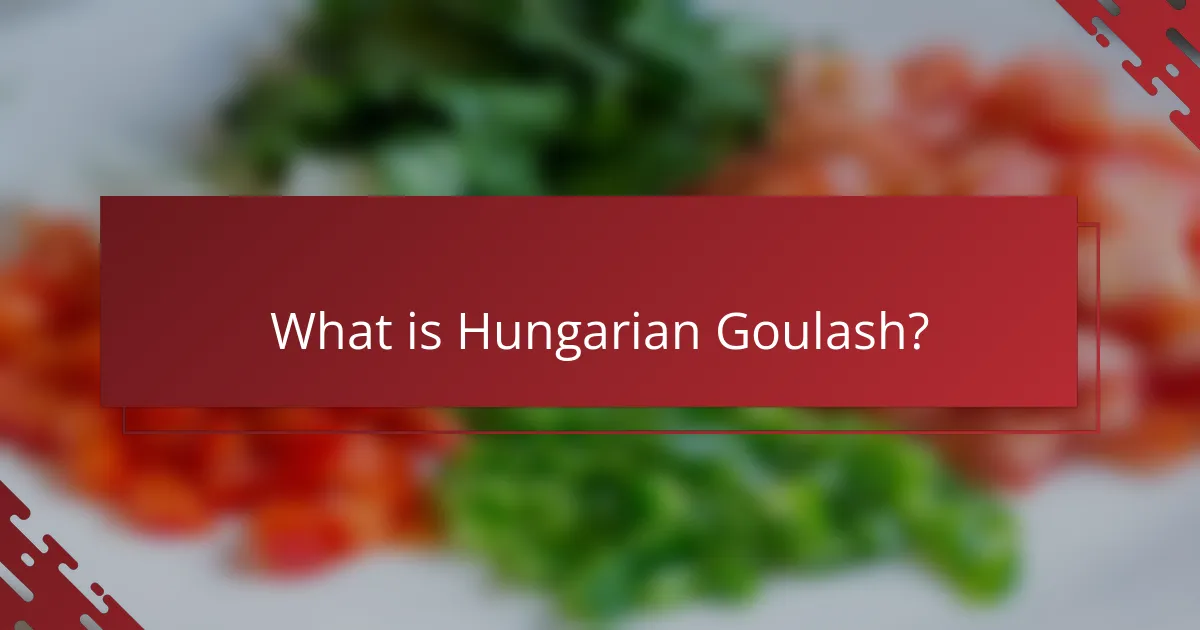Hungarian Goulash is a traditional stew from Hungary, primarily made with beef and seasoned with paprika and various spices. This dish includes vegetables such as onions, potatoes, and carrots, resulting in a rich flavor and thick consistency. The article explores different meat choices for goulash, various cooking styles like slow cooking and braising, and the best serving accompaniments, including crusty bread, dumplings, and rice. Additionally, it highlights the historical significance of Hungarian Goulash, tracing its origins back to the 9th century, and emphasizes the cultural importance of this hearty dish in Hungarian cuisine.

What is Hungarian Goulash?
Hungarian Goulash is a traditional stew originating from Hungary. It primarily consists of meat, often beef, seasoned with paprika and other spices. The dish typically includes vegetables such as onions, potatoes, and carrots. Hungarian Goulash is known for its rich flavor and thick consistency. It is usually served hot, often accompanied by bread or dumplings. The history of Hungarian Goulash dates back to the 9th century, making it a significant part of Hungarian culinary heritage. It is recognized for its simplicity and hearty nature, reflecting the agricultural lifestyle of Hungary.
How is Hungarian Goulash traditionally prepared?
Hungarian Goulash is traditionally prepared by first sautéing onions in fat until golden. Then, beef is added and browned thoroughly. Paprika is a key spice, added to the meat for flavor. Next, water or broth is poured in, along with vegetables like carrots and potatoes. The mixture is simmered until the meat is tender. This dish is typically seasoned with salt and pepper to taste. Traditionally, it is served with bread or dumplings. The preparation method emphasizes slow cooking to develop rich flavors.
What ingredients are essential for authentic Hungarian Goulash?
Essential ingredients for authentic Hungarian Goulash include beef, onions, paprika, tomatoes, and bell peppers. Beef serves as the primary protein source, typically using cuts like chuck or shank. Onions add depth and sweetness to the dish. Paprika, a defining spice of Hungarian cuisine, provides flavor and color. Tomatoes contribute acidity and richness, while bell peppers enhance the overall taste profile. These ingredients are fundamental to achieving the traditional flavor and texture associated with authentic Hungarian Goulash.
What cooking methods are commonly used in its preparation?
Common cooking methods for Hungarian goulash include sautéing, braising, and simmering. Sautéing is often used to brown the meat and enhance flavor. Braising involves cooking the meat slowly in a liquid for tenderness. Simmering allows the ingredients to meld together, creating a rich sauce. These methods are traditional in Hungarian cuisine and are essential for achieving the dish’s characteristic taste and texture.
What are the different types of meat used in Hungarian Goulash?
Hungarian Goulash typically uses beef, pork, or lamb as the main types of meat. Beef is the most common choice, providing a rich flavor and tenderness when cooked slowly. Pork can also be used, adding a different texture and taste. Lamb is less common but offers a unique flavor profile. In some variations, game meats like venison are included, showcasing regional adaptations. These meat choices contribute to the overall depth of flavor in the dish.
How does beef compare to pork in Hungarian Goulash recipes?
Beef is the traditional meat used in Hungarian Goulash recipes, while pork is a less common alternative. Beef provides a richer flavor and a firmer texture, which enhances the dish’s overall depth. Pork, on the other hand, tends to be sweeter and can yield a more tender result when cooked. The choice between beef and pork often depends on regional preferences and family traditions. Many classic recipes specifically call for beef, citing its ability to absorb spices and seasonings effectively. In contrast, pork may require different cooking times and techniques to achieve optimal tenderness and flavor. Overall, while both meats can be used, beef remains the preferred choice for authentic Hungarian Goulash.
What unique flavors do lamb and chicken bring to the dish?
Lamb brings a rich, gamey flavor to dishes, particularly in stews. This distinct taste enhances the depth of the overall dish. Chicken offers a milder, more neutral flavor profile. Its versatility allows it to absorb other spices and ingredients effectively. In Hungarian goulash, lamb adds complexity while chicken provides balance. The combination of these meats can create a layered taste experience. Lamb’s fat content contributes to a hearty texture. Chicken’s lean quality can lighten the dish without sacrificing flavor.
What variations exist in Hungarian Goulash recipes?
Variations in Hungarian Goulash recipes include different meat choices, cooking methods, and ingredient combinations. Traditional recipes often use beef as the primary meat. However, pork and lamb are also popular alternatives. Some versions incorporate game meats like venison. Cooking styles vary between slow simmering and pressure cooking. Ingredients can include potatoes, carrots, and bell peppers, which are not present in all recipes. Seasoning variations exist, with some recipes using caraway seeds or bay leaves. Regional differences may influence the addition of spices like paprika or hot pepper. Each variation reflects local preferences and available ingredients.
How do regional differences influence the ingredients and preparation?
Regional differences significantly influence the ingredients and preparation of Hungarian goulash. In Hungary, the dish typically features beef as the primary meat. However, in neighboring countries, pork or lamb may be preferred based on local livestock availability.
The use of spices also varies by region. Traditional Hungarian goulash relies heavily on sweet paprika, which is abundant in Hungary. In contrast, areas with different culinary traditions may incorporate other spices or herbs, altering the flavor profile.
Preparation methods can differ as well. For instance, some regions may use slow-cooking techniques, while others might prefer quicker methods. This affects the texture and depth of flavor in the final dish.
Additionally, local vegetables play a role in ingredient choice. In Hungary, root vegetables like carrots and potatoes are common. In other areas, seasonal vegetables may be substituted, impacting the overall taste and presentation.
These regional variations reflect the cultural and agricultural practices of each area, showcasing the adaptability of goulash across different culinary landscapes.
What are some popular modern twists on the classic recipe?
Popular modern twists on classic Hungarian goulash include vegetarian versions, using lentils and mushrooms instead of meat. Some recipes incorporate international spices like curry powder or smoked paprika for added flavor. Others feature fusion elements, such as adding coconut milk for creaminess or serving with rice instead of traditional bread. Slow cooker adaptations have gained popularity, allowing for convenient preparation. Additionally, gourmet variations may include unique meats like duck or game for a refined taste. These twists maintain the essence of the original dish while offering innovative flavors and textures.

What cooking styles are commonly associated with Hungarian Goulash?
Hungarian Goulash is commonly associated with slow cooking and braising. These cooking styles allow the flavors to develop deeply. Slow cooking involves simmering the dish over low heat for several hours. This method helps tenderize the meat and blend the spices. Braising combines both moist and dry heat. The meat is first seared and then cooked slowly in liquid. This technique enhances the richness of the goulash. Traditional Hungarian goulash often uses a cast-iron pot for these methods. This ensures even heat distribution and enhances the dish’s flavor profile.
How does slow cooking enhance the flavors of Goulash?
Slow cooking enhances the flavors of Goulash by allowing ingredients to meld over an extended period. This method breaks down tough cuts of meat, making them tender and flavorful. The low heat extracts flavors from spices and vegetables, intensifying the overall taste. Ingredients like paprika, onions, and garlic release their essential oils gradually. This process creates a rich, complex flavor profile that is characteristic of traditional Goulash. Studies show that slow cooking can increase the bioavailability of nutrients and enhance taste. The extended cooking time also allows for the development of deep, savory notes that are often missing in quicker cooking methods.
What equipment is best suited for slow cooking Hungarian Goulash?
A slow cooker is best suited for slow cooking Hungarian Goulash. Slow cookers provide even heat distribution. They allow flavors to meld over several hours. A Dutch oven is also effective for this purpose. It retains heat well and can be used on the stovetop or in the oven. Both options facilitate tenderizing tough cuts of meat. They enhance the dish’s rich flavor profile. Using these tools ensures a well-cooked, hearty goulash.
What tips can improve the slow cooking process?
Use a good quality slow cooker for optimal results. A reliable appliance maintains consistent low temperatures. Cut meat into uniform pieces for even cooking. This ensures all ingredients cook at the same rate. Layer ingredients properly, with denser items at the bottom. This prevents them from burning and allows for even heat distribution. Avoid opening the lid frequently. Each time the lid is lifted, heat escapes and prolongs cooking time. Use the right amount of liquid; too much can dilute flavors, while too little can cause burning. Seasoning should be added at different stages; initial seasoning enhances the base flavor, while final adjustments can enhance the dish before serving.
What role does pressure cooking play in preparing Goulash?
Pressure cooking significantly reduces the cooking time for goulash. It allows the meat to become tender in a fraction of the time compared to traditional methods. This method also helps to intensify the flavors by sealing in the ingredients’ moisture. Pressure cooking can enhance the overall consistency of the dish, resulting in a richer sauce. Additionally, it maintains the nutritional value of the ingredients better than longer cooking methods. Studies show that pressure cooking can reduce cooking times by up to 70%. This efficiency makes it a popular choice for preparing hearty dishes like goulash.
How does pressure cooking impact the texture of the meat?
Pressure cooking tenderizes meat significantly. The high-pressure environment breaks down collagen and connective tissues. This process results in a softer texture. Additionally, pressure cooking retains moisture, preventing the meat from drying out. The cooking time is reduced, which helps maintain the meat’s juiciness. Studies show that pressure cooking can reduce cooking time by up to 70%. This method enhances the overall mouthfeel of the meat in dishes like Hungarian goulash.
What are the time savings associated with pressure cooking Goulash?
Pressure cooking Goulash saves significant time compared to traditional methods. It reduces cooking time from about two to three hours to approximately 30 to 45 minutes. This is due to the high-pressure environment that cooks food faster. The pressure cooker also tenderizes tougher cuts of meat effectively in less time. Studies show that pressure cooking can save up to 70% of the cooking time for stews and similar dishes. Therefore, pressure cooking Goulash is a time-efficient method, making it ideal for busy cooks.

What are the best serving accompaniments for Hungarian Goulash?
The best serving accompaniments for Hungarian Goulash include crusty bread, dumplings, and rice. Crusty bread is ideal for soaking up the rich sauce. Dumplings, particularly nokedli, complement the dish’s flavors. Rice serves as a neutral base that balances the goulash’s spices. Additionally, a side of pickles can enhance the overall taste experience. These accompaniments are traditional and widely enjoyed with goulash in Hungary.
How can side dishes enhance the overall dining experience?
Side dishes enhance the overall dining experience by complementing the main dish and providing variety. They introduce different flavors and textures that enrich the meal. For example, a creamy potato side can balance the richness of Hungarian goulash. This contrast can elevate the overall taste profile.
Additionally, side dishes can contribute to the visual appeal of the plate. A colorful arrangement can make the dining experience more enjoyable. Studies show that visually appealing meals can increase satisfaction levels. Furthermore, side dishes can cater to dietary preferences, offering options for various guests.
In summary, side dishes play a crucial role in enhancing flavor, presentation, and inclusivity during meals.
What traditional bread pairs well with Goulash?
Traditional bread that pairs well with Goulash is crusty bread, such as a rustic sourdough or a hearty rye. These types of bread complement the rich flavors of Goulash. The texture of crusty bread allows for easy dipping into the stew. Sourdough has a tangy flavor that balances the savory spices in Goulash. Rye bread offers a robust taste that enhances the overall meal experience. Both bread types are commonly served alongside Goulash in Hungarian cuisine. They provide a satisfying contrast to the tender meat and thick sauce.
What salads or vegetables complement the dish nicely?
Cucumber salad and coleslaw complement Hungarian goulash nicely. Cucumber salad provides a refreshing crunch that balances the dish’s richness. Coleslaw adds a tangy flavor and crisp texture, enhancing the overall meal experience. Both salads are commonly served alongside goulash in Hungarian cuisine. They offer a contrast to the warm, hearty nature of the goulash. These accompaniments are easy to prepare and can be made in advance. They also add nutritional value to the meal, providing vitamins and fiber.
What are some popular beverages to serve with Hungarian Goulash?
Popular beverages to serve with Hungarian Goulash include red wine, beer, and mineral water. Red wine, particularly a medium-bodied variety like Cabernet Sauvignon, complements the rich flavors of the goulash. Beer, especially a lager or pale ale, pairs well with the dish’s hearty nature. Mineral water provides a refreshing contrast to the spices in the goulash. These beverages enhance the overall dining experience and balance the dish’s flavors.
How does wine choice affect the meal’s flavor profile?
Wine choice directly influences a meal’s flavor profile by complementing or contrasting the dish’s ingredients. For example, a full-bodied red wine enhances the richness of meat-based dishes like Hungarian goulash. The tannins in red wine can soften the flavors of fatty cuts of meat. Conversely, a white wine may brighten the dish with acidity, cutting through the richness. The wine’s fruitiness can also add depth to the meal’s overall taste. Pairing wine with specific herbs and spices in goulash can elevate the dish’s aromatic qualities. Studies show that wine can enhance the perception of flavors, making a well-chosen pairing crucial.
What non-alcoholic options work well with Goulash?
Non-alcoholic options that work well with goulash include sparkling water, herbal teas, and fruit juices. Sparkling water complements the dish’s richness without overwhelming flavors. Herbal teas, such as chamomile or mint, provide a soothing balance. Fruit juices like apple or cranberry add a refreshing contrast to the savory notes. These pairings enhance the overall dining experience while maintaining a harmonious flavor profile.
What practical tips can improve your Hungarian Goulash cooking experience?
Use quality ingredients to enhance flavor. Fresh vegetables and high-quality meat are essential. Choose beef chuck for tenderness and rich taste. Cut meat into uniform pieces for even cooking. Brown the meat thoroughly to develop depth of flavor. Use sweet Hungarian paprika for authentic taste. Add spices gradually to control flavor intensity. Simmer slowly for at least two hours to tenderize the meat. Serve with traditional sides like crusty bread or dumplings for a complete meal.
Hungarian Goulash is a traditional stew from Hungary, primarily made with beef, paprika, and various vegetables. This article explores essential ingredients, traditional cooking methods, and variations of the dish, highlighting the use of meats such as beef, pork, and lamb. Additionally, it discusses modern adaptations, slow cooking techniques, and the best serving accompaniments, including bread and beverages, enhancing the overall dining experience. The article aims to provide a comprehensive understanding of Hungarian Goulash, its preparation, and cultural significance.